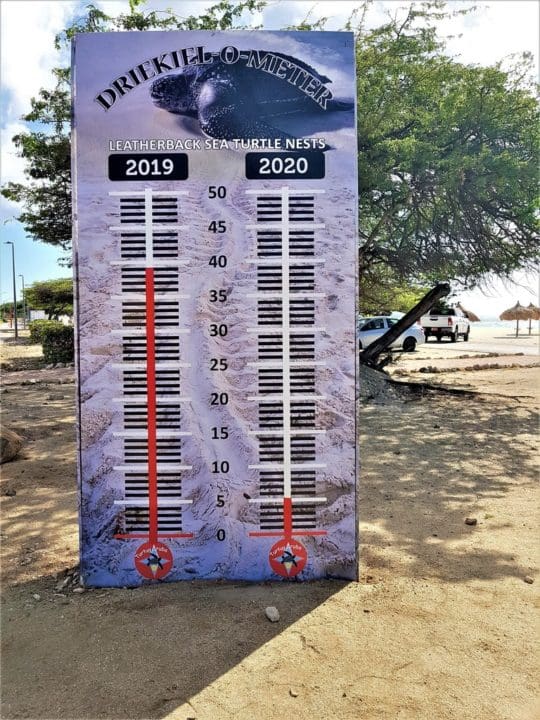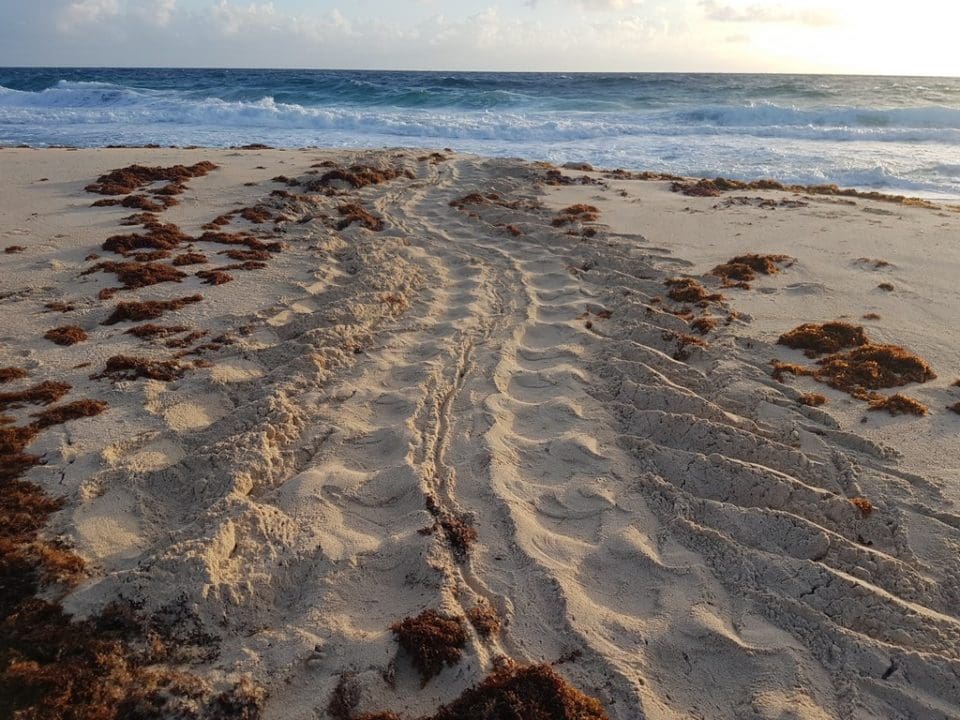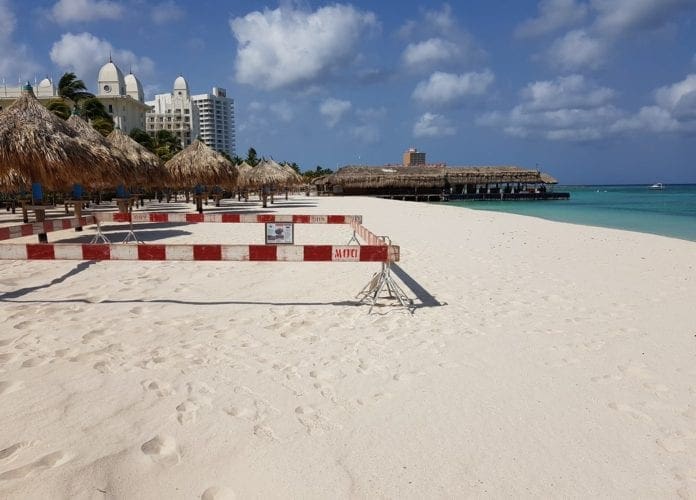Mientras cu nos comunidad ta keda cas y ta pasando den un periodo dificil aworaki, esaki no ta stroba e turtuganan marino pa sigui cu nan ritmo natural. Tin cinco neishi caba na e costa pabou di nos isla, cuater na Eagle Beach cu Low Rise Hotels, y un neishi na Palm Beach.
Antes, prome cu desaroyo turistico extensivo, Palm Beach tabata un nesting habitat importante pa turtuganan. Einan den e añanan nobenta y cuminsamento di 2000 Turtugaruba a guia hopi Driekiel hatchlings (turtuga baby) pa drenta lama. Ta posibel cu e condicionnan di e momento aki, cu un beach trankil cu menos hende of luz anochi, e turtuganan lo regresa mas na Palm Beach atrobe e aña aki.
Driekielnan cu ta pone webo na Aruba no ta biba den Caribe, sino den e parti nort di e ocean Atlantico, banda di Nova Scotia, Canada! Eynan nan ta busca y haña nan cuminda preferi: jellyfish grandi. Pero nan a nace na Aruba si.

Ora nan a madura (esaki ta tuma mas o menos 20 aña pa e Driekiel), un hembra ta bolbe bek na su playa natal pa pone webo (maart- juli). Kinan e ta pone un averahe di siete neishi durante su temporada, y despues lo bolbe bek na e awanan friu di Atlantico pa dos of tres aña prome cu e lo rebolbe pa un otro temporada di anidacion na Aruba.
Driekiel y tur especie di turtuga marino ta den peliger di extincion mundialmente y nan tin mester di nos protection.
Manera ta custumber, neishinan di 2020 tambe ta wordo marca cu e barricadanan cora-blanco di DOW. Despues di 60 pa 70 dia e chikitonan lo bai sali. Na e momento aki nos beachnan ta keto, pero con e situacion lo ta aki dos luna? Lo tin hopi hende riba e beach atrobe? Y mas luz anochi?
Luz artificial por stroba e turtuga di traha neishi, causando cu e turtuga lo drenta lama bek sin pone webo si e no ta sinti su mes safe. Probablemente lo purba siguiente anochi un biaha mas, pero si pa varios biaha e no ta logra, e por laga su webonan cay den awa. Unda full e neishi lo bai perdi.

Con pa yuda proteha e turtuganan?
Awor cu e reglanan ta conta di Shelter In Place den dia y Toque de Queda anochi, no tin hopi chens cu e gran publico lo topa cu un turtuga riba beach.
Pero, den caso di haci ehercicio riba un beach, y haya rastronan of un neishi di turtuga, por fabor yama Turtle Hotline 24/7 mesora (+297 5929393).
Pa tur hende cu pa casualidad por topa un turtuga riba beach, Polis of Security ,ora di traha warda por ehempel, por fabor mantene na e siguiente puntonan pa yuda proteha e turtuga.
Ora ta observa un turtuga subiendo tera of riba beach poniendo webo:
- Na prome lugar tuma contacto cu Turtugaruba (Turtle Hotline + 297 5929393)
- No acerca e turtuga, mantene distancia (por lo menos 15 meter).
- No usa ningun sorto di luz, manera flashlight, camera cu flash of e pantaya di telefon. Paga tur e luznan den vecindario. “Sea turtles dig the dark”. Nunca dirigi e luz riba e turtuga.
- Limita movecion y sonido pa no distrae e turtuga.
- No purba yuda e turtuga bai bek lama pero percura pa e caminda pa lama ta habri y cu no tin hende entre e turtuga y lama. Si su wowo no wordo molestia pa luz artificial e turtuga lo regresa lama sin problema.
- Full e proceso por tuma dos ora.
Pa mas informacion por tuma contacto cu Turtugaruba:
TURTLE-HOTLINE: + 297 5929393 E-mail : [email protected] Facebook
Di antemano nos kier gradici tur hende pa nan contibucion na e conservacion di nos turtuganan marino.
Sea turtle nesting season is underway
While we humans are currently at home in this COVID-19 period, the sea turtles continue to follow their natural routine. There are five Leatherback (Driekiel) nests on the west coast of our island already, four at the Eagle Beach / Low Rise Hotels area and one on Palm Beach.

In recent years we rarely see a turtle nest on Palm Beach, but this used to be an important nesting area. In the 1990s and early 2000s, Turtugaruba, (the Aruban foundation for the conservation of sea turtles) has led many Leatherback hatchlings (baby turtles) to the sea on that beach. Under the current circumstances of a quiet beach and less light at night, it is possible that the adult Leatherbacks will return to laying eggs on Palm Beach this season.
Leatherback sea turtles that nest in Aruba do not live in the Caribbean Sea, but in the North of the Atlantic Ocean and were born on the Aruban beach. When a Leatherback female is mature (after 20 – 30 years) she returns to her native beach to lay eggs during the nesting season (March to July). A Leatherback lays an average of seven nests per season. After the last clutch she leaves again for the cold waters of the Atlantic Ocean where she will stay for two or three years before returning for another season.
Leatherbacks and all sea turtle species are endangered species worldwide and need our protection.
Like every year, nests from 2020 are marked with DOW’s well-known red and white barricades. The nest can hatch after 60 to 70 days of incubation. At the moment our beaches are quiet, but what will the situation be like in two months? Full of people and more light at night?
Artificial light and sea turtles do not go well together. The adult sea turtles feel frightened by artificial light, causing them to not come up the beach far enough to find a good nesting place. If a sea turtle is disturbed during multiple nesting attempts, she might even give up and drop the eggs into the sea. That nest then is lost .
When a nest hatches in the night after two months, the little hatchlings are attracted to artificial light, and they will not reach the sea on their own due to disorientation.
What to do to protect the sea turtles?
With Shelter In Place’s rules in place during the day and Curfew at night, people are unlikely to find a sea turtle on the beach. However, while walking on a beach during the day for one’s own physical health, sea turtle tracks or a nest may be observed.
Please notify Turtugaruba immediately: Turtle Hotline 24/7 (+297 5929393).
And a special request to the people who have to go out at night (such as Police and Security) to continue respecting the following points.
When you see a sea turtle that comes / is ashore to nest:
• Contact Turtugaruba immediately (Turtle Hotline +297 5929393)
• Do not approach the sea turtle, but keep a distance (at least 15 meters).
• Do not use any kind of light, such as a flashlight, flash camera or phone screen. Turn off all lights in the area and never direct light towards a sea turtle.
• Limit movement and noise around the sea turtle to prevent distraction.
• Make sure that the sea turtle can return to the sea undisturbed after nesting, do not stand between the sea turtle and the sea.
• The total nesting process takes an average of 2 hours.
For more information, please contact Turtugaruba:
TURTLE-HOTLINE: + 297 5929393 E-mail : [email protected] Facebook
Legseizoen van de zeeschildpadden gaat zijn gang
Terwijl wij mensen momenteel thuis zitten in de moeilijke Corona periode blijven de zeeschildpadden hun normale ritme volgen. Er zijn al vijf Driekiel (Leatherback) nesten aan de westkust van ons eiland, vier op het strand van Eagle Beach/Low Rise Hotels en een nest op Palm Beach.
De laatste jaren zien we zelden een schildpadnest op Palm Beach, maar vroeger was dit een belangrijk nest gebied. In de jaren negentig en begin van 2000 heeft Turtugaruba, (de Arubaanse stichting die zich bezig houdt met de bescherming van de zeeschildpadden) heel wat Driekiel hatchlings (baby schildpadjes) naar de zee geleid op dat strand. Onder de huidige omstandigheden van een stil strand en minder verlichting ’s avonds is het mogelijk, dat een volwassen Driekiel weer terugkeert naar Palm Beach om haar eieren te leggen, zoals inmiddels gebeurd is.
Driekiel schildpadden die nestelen op Aruba wonen niet in de Caribische Zee, maar in het noorden van de Atlantische Oceaan. Ze zijn wel geboren op het Arubaanse strand. Als een Driekiel vrouwtje volwassen is (na 20 – 30 jaar) keert ze terug naar haar geboortegrond om eieren te leggen in het legseizoen (maart tot juli). Een Driekiel legt gemiddeld zeven nesten per seizoen. Na het laatste nest vertrekt ze weer naar de koude wateren van de Atlantische Oceaan. Ze komt niet elk jaar dat hele eind hierheen zwemmen om eieren te leggen, maar zij doet dat om de twee of drie jaar.
De Driekiel en alle zeeschildpadsoorten zijn wereldwijd met uitsterven bedreigd en hebben onze bescherming nodig.
Zoals ieder jaar, zijn nesten ook in 2020 afgezet met de bekende rood-witte balken van DOW. Na 60 tot 70 dagen incubatie kan het nest uitkomen. Op dit moment zijn onze stranden rustig, maar hoe zal de situatie over twee maanden zijn? Vol mensen en ’s nachts weer meer licht?
Kunstlicht en zeeschildpadden gaan niet goed samen. De volwassen schildpadden komen niet ver genoeg het strand op om een goede nestplaats te kiezen als ze gestoord worden door licht. Dan voelen zij zich niet veilig. Het komt zelfs voor dat zij zonder een nest te maken terugkeren naar het water en de eieren in zee laten vallen. Dat nest is dan verloren.
En als er over twee maanden een nest in de nacht uitkomt, worden de kleintjes juist aangetrokken door kunstlicht, en zullen zij door desoriëntatie de zee niet op eigen kracht bereiken.
Wat te doen om de zeeschildpadden te beschermen?
Nu de regels overdag van Shelter In Place en de Avondklok ’s nachts van kracht zijn, is de kans niet zo groot dat mensen een schildpad op het strand zullen vinden. Maar tijdens lopen op een strand overdag voor de eigen lichamelijke gezondheid, worden er misschien wel sporen van een zeeschildpad of zelfs een nest waargenomen.
Geef dit a.u.b. meteen door aan Turtugaruba: Turtle Hotline 24/7 (+297 5929393).
En een speciaal verzoek aan de mensen (zoals Politie en Security) die wel ‘s nachts op stap moeten, om de volgende punten te blijven respecteren.
Bij het zien van een zeeschildpad, die aan land komt/is om te nestelen:
- Neem direct contact op met Turtugaruba (Turtle Hotline +297 5929393)
- Loop niet op het dier af, maar blijf op een afstand (minstens 15 meter).
- Gebruik geen enkele vorm van licht, zoals zaklantaarn, camera met flits of het scherm van een telefoon. Doe alle lichten in de omgeving uit en schijn nooit op een zeeschildpad.
- Beperk beweging en geluid rond het dier om het niet af te leiden.
- Zorg dat de schildpad na het eieren leggen ongestoord terug kan naar de zee, ga niet tussen het dier en de zee staan.
- Het totale nest proces duurt gemiddeld 2 uur.
- Voor meer informatie kunt u contact opnemen met Turtugaruba:
TURTLE-HOTLINE: + 297 5929393 E-mail : [email protected]























